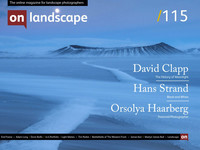The core DNA of photography

Hans Strand
Hans Strand is an internationally recognised photographer who has received numerous awards for his work and published three books. He lives near Stockholm in Sweden.
If I did not have to make my living from photography, I would stick with black & white. There is so much more freedom in black & white than in colour. To start with, it is a total manipulation of what you are seeing. A reduction of all colours into a monochrome interpretation. This in itself creates a new reality. In colour, I always make the comparison between the colours in my image and the ones I saw in real life. Green especially is a nightmare for me. I have a continuous fight with the colour green. It simply does not come out as subtle as it does on my retina. In black & white I can just forget about this problem and concentrate on the contrast and tonal range. This does not make the photography more simple, it is more difficult to make a good black & white photograph than with one in colour. To make it sing, the contrast often needs to fill out the entire tonal scale, from black to white. First of all, we see things in colour and a skilled visualisation is crucial to get a functional tonal scale. What works in colour will often not work in black & white. Complementary colours contrast nicely in colour, but in black & white they might come out as the same grey tone. It is when photographer nails the contrast between the elements in his/her composition that a black & white photograph really sings.
Green especially is a nightmare for me. I have a continuous fight with the colour green. It simply does not come out as subtle as it does on my retina. In black & white I can just forget about this problem and concentrate on the contrast and tonal range. This does not make photography more simple, it is more difficult to make a good black & white photograph than with one in colour. To make it sing, the contrast often needs to fill out the entire tonal scale, from black to white. First of all, we see things in colour and a skilled visualisation is crucial to get a functional tonal scale. What works in colour will often not work in black & white. Complementary colours contrast nicely in colour, but in black & white they might come out as the same grey tone. It is when photographer nails the contrast between the elements in his/her composition that a black & white photograph really sings.
When I am visiting photography fairs, I often find myself browsing over colour exhibitions quickly, whereas I tend to spend more time scrutinising the black & whites. Why is that? A photograph normally carries some content, a message or a feeling.

